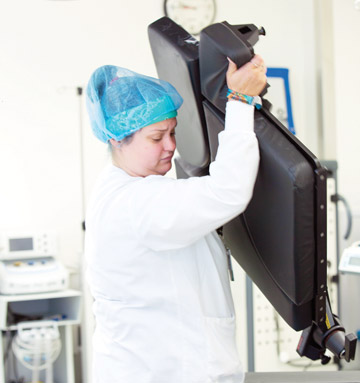As the ergonomics and injury prevention specialist for 11 hospitals, I was responsible for tracking the causes of the most frequent and severe injuries by department, by job title and by body part, and using this information to develop action plans focused on decreasing injury rates. During my career, I worked with numerous surgical team members who suffered workplace injuries associated with
- lifting and transferring patients onto and off of OR tables;
- lifting and moving heavy equipment; and
- standing during long procedures, especially when leaning forward or twisting to assist the surgeon.
My job let me identify not only how your nurses and techs can get hurt, but also how you can look out for their well-being as they focus more on patient care than on protecting themselves from harm.
- Understand the risks. Research shows most nurses who suffer injuries don’t report them (osmag.net/aR5pCQ). Future studies should therefore explore organizational factors that contribute to this concern, and establish strong policies to promote the health and safety of workers in the trenches. Having someone in a leadership position who is trusted and viewed as empathetic could lead to more nurses reporting injuries before injury rates get worse.
Do your part by observing nurses in action to identify potential dangers they might not realize they face. Distribute department- or unit-specific (pre-op, OR, PACU) confidential surveys. Ask team members about areas of discomfort or pain (lower back, upper back, neck, shoulders, legs) associated with specific actions and physically difficult tasks that cause them the most discomfort or that they consider the highest risk.
Musculoskeletal injuries are a recurring problem among OR nurses, with as many as 66.1% suffering from musculoskeletal disorders (osmag.net/YUS3tv). Holding a patient’s limb in place for extended periods can even take a toll. A patient’s leg typically weighs about 16% of their total body weight. If a patient weighs 250 lbs., a nurse may be required to lift and hold about 39 lbs., which is beyond a safe limit, especially if the nurse has to bend forward when grasping the leg.
Slips and falls also continue to be a recurring problem. I investigated one case where an anesthesiology technician was working between 2 ORs. She walked quickly out of one OR and into the hallway, which had just been mopped, slipped and fell and tore her meniscus. Unfortunately, her surgery and recovery did not go well.
- Take action. Review the findings of the surveys and share your observations with clinical managers, then develop, prioritize and implement injury prevention action items. This process should include asking staff who participated in the surveys for their feedback and suggestions for feasible safety-related solutions. Establish short- and long-term goals, identify barriers and challenges to achieving these goals, and hold directors and managers accountable for meeting them.
Conduct a thorough investigation of all employee injuries, including a standardized interview process for the injured employee, the employee’s manager and direct supervisor, and any co-workers involved in the incident. If opportunities and action items for preventing similar injuries are identified, discuss the actions with appropriate administrators and committees, and quickly implement them.
- Own it. Embrace your role and responsibility in keeping your employees safe. Check in with them on a regular basis, asking about any ongoing problems or concerns they have regarding risk of injuries to themselves, their colleagues or their patients. Respond to their concerns promptly and appropriately with adjusted or new action items. Make sure employees feel empowered to report safety issues either anonymously or during staff meetings. Regular risk analyses and follow-up staff surveys should be part of an your ongoing safety monitoring process.
.svg?sfvrsn=be606e78_3)

.svg?sfvrsn=56b2f850_5)